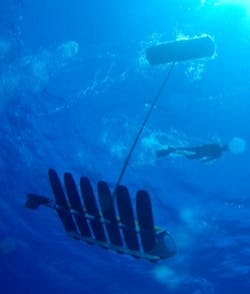THEODORE, AL, Aug. 25, 2010 -- As part of its long term monitoring and research program in the Gulf of Mexico, BP is deploying a new technology that will enable nearly constant monitoring by two satellite-controlled, unmanned vehicles.
The vehicles, known as Wave Gliders and developed by Liquid Robotics in Silicon Valley, California, get their propulsion power from wave action and use solar power for their electronics. They will be deployed beginning today and begin a months-long, ongoing research program in the Gulf of Mexico.
"These vehicles will provide us a steady stream of data about water quality and should significantly increase the available data for ongoing research activity," said Mike Utsler, chief operating office of BP's Gulf Coast Restoration Organization. "We will initially deploy the Wave Gliders between the Macondo well and the shoreline, and look to expand from there in the future."
The unique technology allows deployment of sensors persistently, for the long term, to monitor key environmental variables, including:
• water quality -- detection of any emulsified, dissolved and dispersed oil in water; phytoplankton (chlorophyll); colored, dissolved oxygen matter (CDOM) and other scientifically useful variables
• marine mammal vocalizations
• weather and water temperature data.
"Initially we will be calibrating a set of nine optical sensors to monitor water quality, including trace amounts of dispersed oil, and will then add acoustic monitoring of marine mammal activity," said Roger Hine, president and CEO of Liquid Robotics. "We look forward to working with BP on this extended research program."
The first two Wave Glider vehicles will be deployed to the vicinity of the Macondo well; a second pair will be deployed in September. Data collected by the vehicles will be relayed via satellite and posted on a public website.
Note to editors: A fact sheet with more details of the Wave Glider technology is included at the bottom of this document.
###




